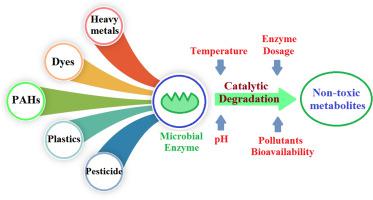Journal of Hazardous Materials ( IF 12.2 ) Pub Date : 2021-06-21 , DOI: 10.1016/j.jhazmat.2021.126451 A Saravanan 1 , P Senthil Kumar 2 , Dai-Viet N Vo 3 , S Jeevanantham 1 , S Karishma 1 , P R Yaashikaa 4

|
Industrialization and other human anthropogenic activities cause serious threats to the environment. The toxic pollutants can cause detrimental diseases on diverse living beings in their respective ecosystems. Bioremediation is one of the efficient remediation methods in which the toxic pollutants are removed from the environment by the application of microorganisms or their biologically active products (enzymes). Typically, the microorganisms in the environment produce various enzymes to immobilize and degrade the toxic environmental pollutants by utilizing them as a substrate for their growth and development. Both the bacterial and fungal enzymes can degrade the toxic pollutants present in the environment and convert them into non-toxic forms through their catalytic reaction mechanism. Hydrolases, oxidoreductases, dehalogenases, oxygenases and transferases are the major classes of microbial enzymes responsible for the degradation of most of the toxic pollutants in the environment. Recently, there are different immobilizations and genetic engineering techniques have been developed to enhance enzyme efficiency and diminish the process cost for pollutant removal. This review focused on enzymatic removal of toxic pollutants such as heavy metals, dyes, plastics and pesticides in the environment. Current trends and further expansion for efficient removal of toxic pollutants through enzymatic degradation are also reviewed in detail.
中文翻译:

毒性环境污染物的催化酶降解综述:微生物酶
工业化和其他人类人类活动对环境造成严重威胁。有毒污染物会对各自生态系统中的各种生物造成有害疾病。生物修复是利用微生物或其生物活性产物(酶)从环境中去除有毒污染物的有效修复方法之一。通常,环境中的微生物会产生各种酶来固定和降解有毒的环境污染物,利用它们作为其生长和发育的底物。细菌和真菌酶都可以降解环境中存在的有毒污染物,并通过其催化反应机制将其转化为无毒形式。水解酶、氧化还原酶、脱卤酶、加氧酶和转移酶是主要类别的微生物酶,负责降解环境中的大多数有毒污染物。最近,已经开发出不同的固定化和基因工程技术来提高酶的效率并降低污染物去除的过程成本。这篇综述的重点是酶法去除环境中的重金属、染料、塑料和杀虫剂等有毒污染物。还详细回顾了通过酶促降解有效去除有毒污染物的当前趋势和进一步扩展。已经开发了不同的固定化和基因工程技术来提高酶的效率并降低污染物去除的过程成本。这篇综述的重点是酶法去除环境中的重金属、染料、塑料和杀虫剂等有毒污染物。还详细回顾了通过酶促降解有效去除有毒污染物的当前趋势和进一步扩展。已经开发了不同的固定化和基因工程技术来提高酶的效率并降低污染物去除的过程成本。这篇综述的重点是酶法去除环境中的重金属、染料、塑料和杀虫剂等有毒污染物。还详细回顾了通过酶促降解有效去除有毒污染物的当前趋势和进一步扩展。










































 京公网安备 11010802027423号
京公网安备 11010802027423号